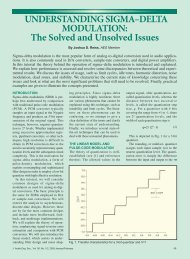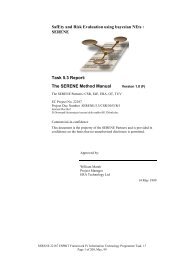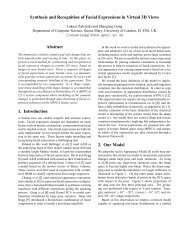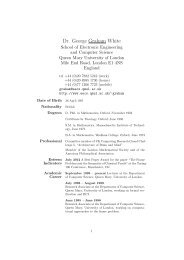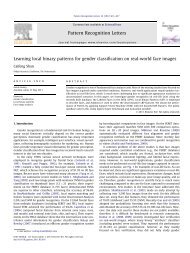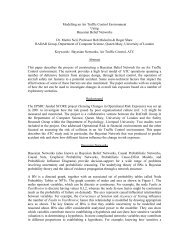DEAP: A Database for Emotion Analysis using Physiological Signals
DEAP: A Database for Emotion Analysis using Physiological Signals
DEAP: A Database for Emotion Analysis using Physiological Signals
You also want an ePaper? Increase the reach of your titles
YUMPU automatically turns print PDFs into web optimized ePapers that Google loves.
IEEE TRANS. AFFECTIVE COMPUTING 11<br />
TABLE 5<br />
Features extracted from EEG and physiological signals.<br />
Signal Extracted features<br />
GSR average skin resistance, average of derivative, average<br />
of derivative <strong>for</strong> negative values only (average decrease<br />
rate during decay time), proportion of negative samples<br />
inthederivativevs.allsamples,numberoflocal minima<br />
in the GSR signal, average rising time of the GSR<br />
signal, 10 spectral power in the [0-2.4]Hz bands, zero<br />
crossing rate of Skin conductance slow response (SCSR)<br />
[0-0.2]Hz, zero crossing rate of Skin conductance very<br />
slow response (SCVSR) [0-0.08]Hz, SCSR and SCVSR<br />
mean of peaks magnitude<br />
Blood<br />
volume<br />
pressure<br />
Respiration<br />
pattern<br />
Skin temperature<br />
EMG and<br />
EOG<br />
Average and standard deviation of HR, HRV, and inter<br />
beatintervals,energyratiobetweenthefrequencybands<br />
[0.04-0.15]Hz and [0.15-0.5]Hz, spectral power in the<br />
bands ([0.1-0.2]Hz, [0.2-0.3]Hz, [0.3-0.4]Hz), low frequency<br />
[0.01-0.08]Hz, medium frequency [0.08-0.15]Hz<br />
and high frequency [0.15-0.5]Hz components of HRV<br />
power spectrum.<br />
band energy ratio (difference between the logarithm of<br />
energy between the lower (0.05-0.25Hz) and the higher<br />
(0.25-5Hz) bands), average respiration signal, mean of<br />
derivative (variation of the respiration signal), standard<br />
deviation, range or greatest breath, breathing rhythm<br />
(spectral centroid), breathing rate, 10 spectral power in<br />
the bands from 0 to 2.4Hz, average peak to peak time,<br />
median peak to peak time<br />
average, average of its derivative, spectral power in the<br />
bands ([0-0.1]Hz, [0.1-0.2]Hz)<br />
eye blinking rate, energy of the signal, mean and variance<br />
of the signal<br />
EEG theta, slow alpha, alpha, beta, and gamma Spectral<br />
power <strong>for</strong> each electrode. The spectral power asymmetry<br />
between 14 pairs of electrodes in the four bands of<br />
alpha, beta, theta and gamma.<br />
All the physiological responses were recorded at a<br />
512Hz sampling rate and later down-sampled to 256Hz<br />
toreduceprcoessingtime.ThetrendoftheECGandGSR<br />
signals was removed by subtracting the temporal low<br />
frequency drift. The low frequency drift was computed<br />
bysmoothing thesignals oneachECGandGSRchannels<br />
with a 256 points moving average.<br />
In total 106 features were extracted from peripheral<br />
physiological responses based on the proposed features<br />
in the literature [22], [26], [52]–[54] (see also Table 5).<br />
From the EEG signals, power spectral features were<br />
extracted. The logarithms of the spectral power from<br />
theta(4-8Hz),slowalpha(8-10Hz),alpha(8-12Hz),beta<br />
(12-30Hz) and gamma (30+ Hz) bands were extracted<br />
from all 32 electrodes as features. In addition to power<br />
spectral features the difference between the spectral<br />
power of all the symmetrical pairs of electrodes on<br />
the right and left hemisphere was extracted to measure<br />
the possible asymmetry in the brain activities due to<br />
emotional stimuli. The total number of EEG features of<br />
a trial <strong>for</strong> 32 electrodes is 216. Table 5 summarizes the<br />
list of features extracted from the physiological signals.<br />
6.2 MCA Features<br />
Music videos were encoded into the MPEG-1 <strong>for</strong>mat to<br />
extract motion vectors and I-frames <strong>for</strong> further feature<br />
extraction. The video stream has been segmented at the<br />
shot level <strong>using</strong> the method proposed in [55].<br />
From a movie director’s point of view, lighting key<br />
[30], [56] and color variance [30] are important tools<br />
to evoke emotions. We there<strong>for</strong>e extracted lighting key<br />
from frames in the HSV space by multiplying the average<br />
value V (in HSV) by the standard deviation of the<br />
values V (in HSV). Color variance was obtained in the<br />
CIE LUV color space by computing the determinant of<br />
the covariance matrix of L, U, and V.<br />
Hanjalic and Xu [29] showed the relationship between<br />
video rhythm and affect. The average shot change rate,<br />
and shot length variance were extracted to characterize<br />
videorhythm.Fast moving scenesorobjects’ movements<br />
in consecutive frames are also an effective factor <strong>for</strong><br />
evoking excitement. To measure this factor, the motion<br />
component was defined as the amount of motion in consecutive<br />
frames computed by accumulating magnitudes<br />
of motion vectors <strong>for</strong> all B- and P-frames.<br />
Colors andtheir proportions areimportant parameters<br />
to elicit emotions [57]. A 20 bin color histogram of hue<br />
and lightness values in the HSV space was computed <strong>for</strong><br />
each I-frame and subsequently averaged over all frames.<br />
The resulting bin averages were used as video contentbased<br />
features. The median of the L value in HSL space<br />
was computed to obtain the median lightness of a frame.<br />
Finally, visual cues representing shadow proportion,<br />
visual excitement, grayness and details were also determined<br />
according to the definition given in [30].<br />
Sound also has an important impact on affect. For example,<br />
loudness of speech (energy) is related to evoked<br />
arousal, while rhythm and average pitch in speech signals<br />
arerelatedtovalence[58].The audiochannels of the<br />
videos were extracted and encoded into mono MPEG-3<br />
<strong>for</strong>mat at a sampling rate of 44.1 kHz. All audio signals<br />
were normalized to the same amplitude range be<strong>for</strong>e<br />
further processing. A total of 53 low-level audio features<br />
were determined <strong>for</strong> each of the audio signals. These<br />
features, listed in Table 6, are commonly used in audio<br />
and speech processing and audio classification [59], [60].<br />
MFCC, <strong>for</strong>mants and the pitch of audio signals were<br />
extracted <strong>using</strong> the PRAAT software package [61].<br />
6.3 Fusion of single-modality results<br />
Fusion of the multiple modalities explained above aims<br />
at improving classification results by exploiting the complementary<br />
natureof the differentmodalities. In general,<br />
approaches <strong>for</strong> modality fusion can be classified into<br />
two broad categories, namely, feature fusion (or early<br />
integration) and decision fusion (or late integration) [63].<br />
In feature fusion, the features extracted from signals of<br />
different modalities are concatenated to <strong>for</strong>m a composite<br />
feature vector and then inputted to a recognizer.<br />
In decision fusion, on the other hand, each modality




